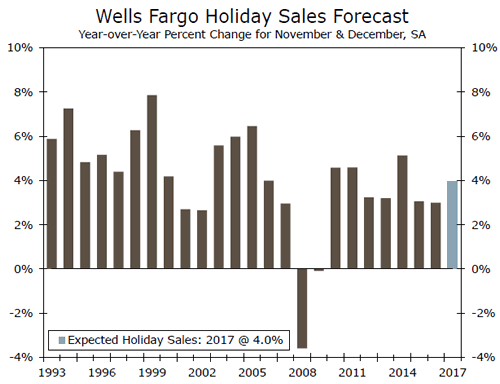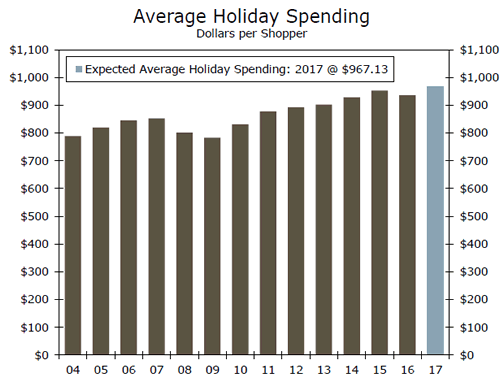U.S. Review
Gobble, Gobble till You Wobble
- There was a light schedule of economic reports released ahead of the Thanksgiving holiday.
- Existing home sales rose solidly in October, with overall sales rising 2 percent. Inventories fell further and the median price of an existing home has risen 5.5 percent over the past year.
- Advance orders for durable goods came in below expectations but nearly all the shortfall was in the highly volatile commercial aircraft component. Orders for the prior month were revised higher and the longer-term trend remains solidly positive.
Looking Good Going into the Holiday Season
The economy looks like it has strong momentum going into the holiday season and consumers, retailers and businesses should all be in a fairly festive mood this year. This week’s limited schedule of economic reports included just four major indicators: existing home sales, advance durable goods orders, weekly unemployment claims and the University of Michigan’s Index of Consumer Sentiment. All of the reports are consistent with the economy throttling back a bit from the 3 percent plus pace averaged during the prior two quarters. In fact, revisions to previously published data suggest that third quarter real GDP growth will be revised higher to 3.2 percent.
Data on existing home sales came in slightly above expectations. Overall sales rose 2.0 percent in October, rising to a 5.48 million unit pace, following a smaller than initially reported 0.4 percent increase in September. Those two gains followed three consecutive monthly drops during the summer months that have raised some concerns that the housing recovery is running out of steam. On a year-to-year basis, existing home sales are running 0.9 percent below their year-ago level.
The apparent weakness in existing homes sales does not appear to be due to a lack of demand. Homes are selling quickly and home prices are rising solidly. The National Association of Realtors noted that the typical home sold in just 34 days and that 47 percent of existing homes sold in one month or less. Homes that are priced around the median of $247,000 or less are also selling very quickly and there are very few homes available at lower price points. The median price of an existing home has risen 5.5 percent over the past year.
The inventory of homes available for sale at the end of October fell 3.2 percent from the prior month to just 1.80 million units. There is just a 3.9 month supply of homes available for sale at the current sales pace, down from 4.4 months one year ago. The number of homes available for sale has tumbled 10.4 percent over the past year, while sales have fallen 1 percent. With inventories down more than 10 times as much as sales, the shortage of homes appears to be the likely culprit of any pullback in sales.
Advance orders for durable goods fell 1.2 percent in October and orders for the key nondefense capital goods component also fell during the month, albeit by a much smaller 0.5 percent, marking their first decline since June. Most of the drop in overall orders was due to an 18.6 percent pullback in orders for nondefense aircraft. That highly volatile component had risen 33 percent or more during each of the past two months and appears to be primed for another big up month, given the strength in orders reported by Boeing and Airbus at the Dubai Air Show.
While nondefense capital goods orders slipped, the longer run trend in orders remains solidly positive. The category provides a good approximation for investment in capital equipment. Orders over the past three months have risen at a 14.5 percent average annual rate and shipments have increased at a 13.1 percent pace, which helps get the fourth quarter off to a strong start.
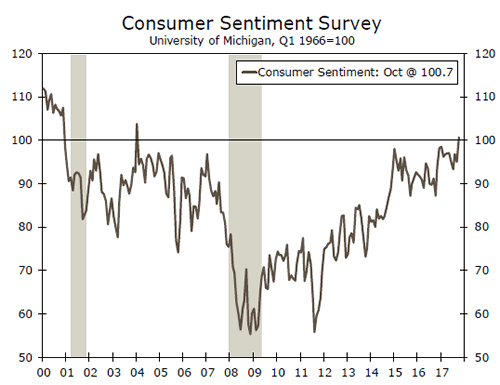
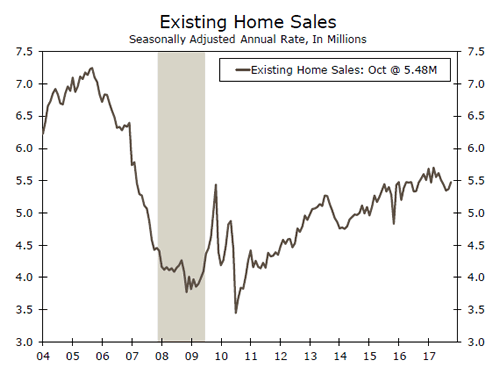
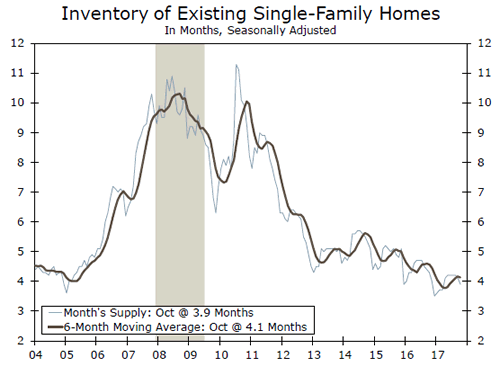
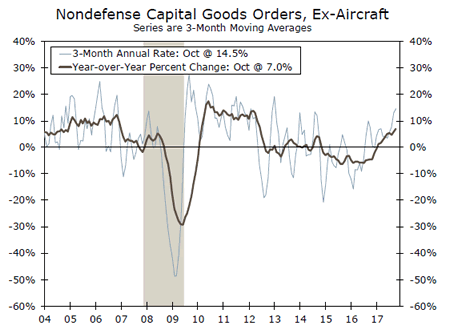
U.S. Outlook
Consumer Confidence Index • Tuesday
Consumer confidence continued its tear in October, rising 5.3 points to 125.9, marking the highest level for consumer confidence since December 2000. The Consumer Confidence Index measures the breadth of confidence rather than its magnitude. The 24.9 percent rise over the past year means more consumers are feeling optimistic about the economy than one year ago. Over this period, consumers’ assessment of the present situation has risen 22.7 percent, while their expectations for economic conditions over the next six months has risen 26.9 percent. This suggests consumers feel more optimistic about the current state of the economy and its future prospects.
We expect consumer confidence to pull back slightly in November but to remain near cycle-high levels.
Previous: 125.9 Wells Fargo: 124.9 Consensus: 124.0
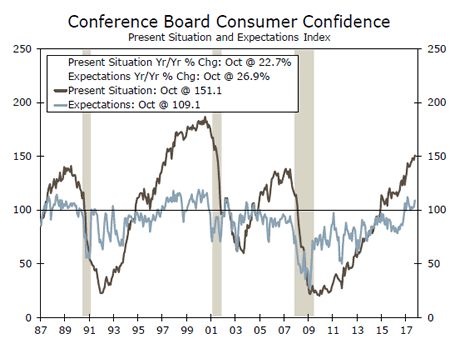
Personal Income & Spending • Wednesday
Real personal spending finished Q3 on a high note, rising 0.6 percent in September and marking the second-fastest monthly growth rate of the past three years. Real consumer spending is up a solid 2.7 percent on the year, where it has hovered for most of 2017.
Personal income growth disappointed again, however, with just a 0.4 percent nominal gain. September’s weak job growth likely weighed on income growth, and we may get a rebound in October. Through the monthly noise, the soft income growth seen in recent months has meant that consumers continue to draw down their saving rate. The saving rate fell to 3.1 percent in September from 3.6 percent during the first two months of Q3, down from as high as 6.0 percent two years ago.
Members of the FOMC will be watching the October print for a rebound in core PCE inflation. Some upward momentum heading into 2018 would bode well for continued fed funds hikes next year.
Previous: 0.4% Wells Fargo: 0.4% Consensus: 0.3% (Month-Over-Month, Income)
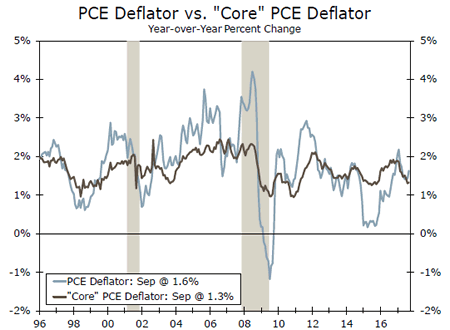
ISM Manufacturing Index • Friday
The ISM manufacturing index retreated slightly in October from its unusually strong September reading. The supplier deliveries subcomponent is still providing an artificial boost to the index, and this effect is likely to fade further in the November reading.
The underlying trend continues to be positive. The six-month averages for the production and new orders subcomponents are above 60, and the employment subcomponent has averaged a respectable 57.7 over the same period. The hard data have backed up the survey, with core capital goods orders rising at a 14.5 percent three-month average annualized rate through October.
We look for the ISM manufacturing index to pull back slightly in November to 58.4. With encouraging fundamentals in place, we expect the slow but steady improvement in the U.S. factory sector to continue in the coming months.
Previous: 58.7 Wells Fargo: 58.4 Consensus: 58.4
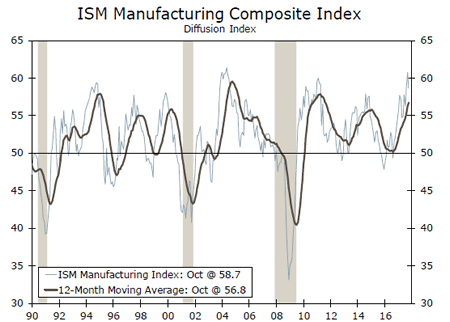
Global Review
In Germany, Political Uncertainty Sets In
- The German economy is booming at present with the yearover- year GDP growth rate standing at a six-year high and unemployment at its lowest rate in the post-reunification period.
- However, Germany is entering into a period of political uncertainty. Negotiations to form a new governing coalition collapsed this week, which could lead to a potentially unstable minority government. Not only could political uncertainty have a knock-on effect on the German economy, but it also makes it harder to pursue further integration in Europe.
In Germany, Political Uncertainty Sets In
This has been a rather quiet week in terms of foreign economic data releases, so we focus on recent political and economic developments in Germany. Following the German general election on September 24, Chancellor Merkel and her Christian Democratic Union (CDU) entered into negotiations with the Free Democrats (FDP) and the Green Party on forming the next government. The collapse of the coalition negotiations that was announced on Sunday is not a huge surprise given the ideological differences among the center-right CDU, the economically liberal FDP and the environmentally-conscious Greens.
So what happens now? There appears to be three options. First, the CDU has been governing Germany in coalition with the center-left Social Democrats (SPD) since the last general election in 2013. In theory, the CDU could form a new "grand coalition" with the SPD, but the latter has ruled out that option. Second, the CDU could govern as a minority government. Because the CDU does not have a majority of seats in the Bundestag, the lower house of the German parliament, it would need to pass legislation with other parties on an ad hoc basis. However, minority governments tend to be unstable because they can easily be brought down by no confidence motions. Third, the federal president could call for a new election. However, President Steinmeier seems reluctant to call new elections, at least at this point, because of the risk that fringe parties could garner even more votes than they did in September. In short, Germany seems set for a period of political uncertainty.
If voters cared only about pocketbook issues the CDU would have been returned overwhelmingly to power in the September elections, because the German economy is booming at present. Real GDP was up 2.8 percent in Q3-2017, the strongest year-overyear rate of growth in six years. Moreover, growth is broad-based at present with consumer spending, investment spending and exports all contributing positively to the overall rate of real GDP growth. Growth in real retail sales has strengthened markedly this year (top chart), and unemployment has declined to the lowest rate in the post-reunification era (middle chart). The Ifo index of German business sentiment stood at an all-time high in October (bottom chart), suggesting that growth has remained buoyant thus far in the fourth quarter.
But pocketbook issues are not the only considerations that motivate citizens to vote for individual candidates or political parties, and Germany has not been immune to the populist/nativist voices that have affected elections in other western countries in recent years. Political uncertainty could have a marginal negative effect on the German economy in the near term, although it is not likely to derail the expansion that is underway in Germany. However, Chancellor Merkel was weakened by the election results, and she will be weakened further if she needs to govern via a minority government. There could also be implications for Europe from the inability to form a coalition. A weakened Merkel will find it harder to persuade other German politicians to agree to the deeper European integration proposals that French President Macron has proposed.
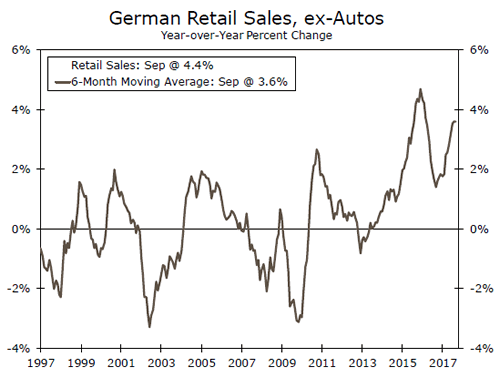
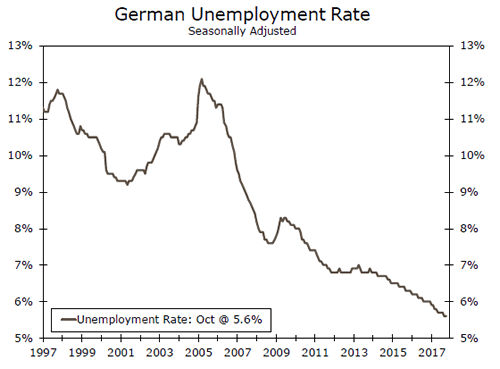
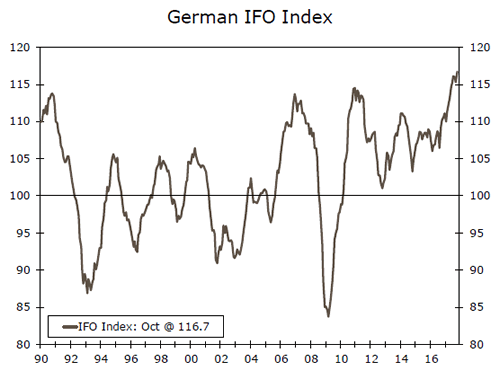
Global Outlook
Germany Retail Sales • Monday
The global economy, the week will start with the release of October retail sales for Germany. The index printed a strong 0.5 percent in September, the first positive reading in three months. On a yearearlier basis, the index was also strong, up 4.1 percent in September, the third consecutive year-over-year improvement.
Meanwhile, markets will also get the GfK consumer confidence index for December. The GfK hit a series high of 10.9 in September while coming down to print 10.7 in November. It will be interesting to see how or if the failure of Angela Merkel to form a governmental coalition has affected consumer confidence in the largest economy in the Eurozone.
Previous: 0.5% (Month-Over-Month)
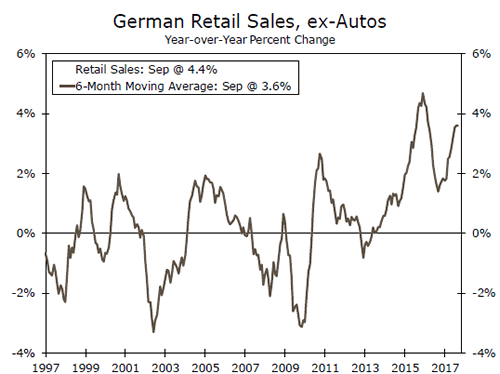
China Manufacturing PMI • Wednesday
Manufacturing activity in China has held steady over the past several months as shown by the manufacturing PMI. In the October reading, the index printed 51.6, down from 52.4 in September. On Wednesday, markets are going to take a look at the November reading. This is the manufacturing PMI that includes large, normally state-owned enterprises.
The services PMI is also going to be released on Wednesday. The index was at 54.3 in October after hitting 55.4 in September. Meanwhile, the Caixin manufacturing PMI, which includes small and medium-sized manufacturing firms that are typically not covered by the official manufacturing PMI will hit the newswires on Thursday. After hitting a series high of 51.9 in December of last year, the index remained at 51.0 in September and October.
Previous: 51.6
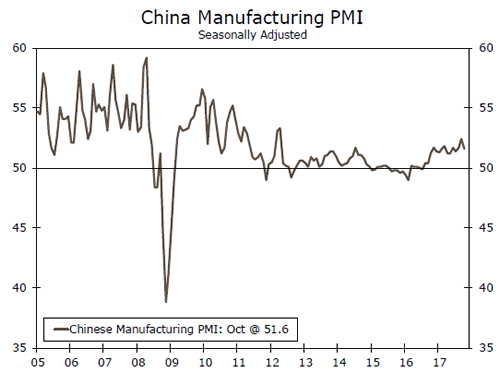
Brazil Q3 GDP • Friday
Brazil will release Q3 GDP on Friday. The year-over-year result for Q2 was 0.3 percent, the first positive year-over-year increase since the first quarter of 2014. Our expectation is for the economy to have posted another increase in the third quarter.
According to the index of economic activity, which is a proxy for the performance of the Brazilian economy, the economy grew 1.4 percent during the third quarter of the year, year over year. Much of the improvement in the economy reflects stronger consumer spending. The appreciation of the currency and the disinflationary process plus the reduction in interest rates over the last year has strengthened the ability of Brazilians to increase consumption.
Previous: 0.3% (Year-Over-Year)
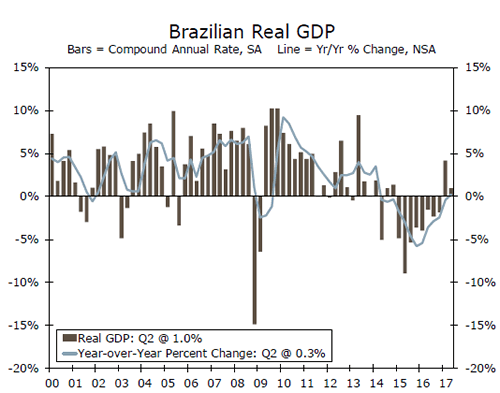
Point of View
Interest Rate Watch
What is up With the Yield Curve?
The yield curve continued to flatten this past week, sparking interest from financial market participants and people looking for a diversion from thinking about the holidays. The spread between the yield on the 10-year Treasury and 2-year Treasury note has shrunk to around 60 basis points, which is the tightest that spread has been since November 2007. The flattening of the yield curve has revived interest in what a flattening yield curve implies for the financial markets and broader economy.
The yield curve’s track record on predicting recessions has been very good, particularly when the curve inverts. An inverted yield curve is a red flag that a recession is less than one year away. The flattening in the yield curve we have seen in recent weeks does not appear to be a precursor to an inversion. Instead, the flattening appears to be driven by technical concerns, including liquidity needs ahead of year-end that are possibly compounded by the increased likelihood of significant tax reform. There is also a near universal conviction among market participants that the Fed will raise rates in December. In addition, Treasury issuance has increased at the short end of the curve but remained somewhat muted at the long end.
Long-term bonds remain in high demand, driven by an aging population in the developed world and voracious appetite from pension funds, insurance firms and other large long-term savers. The yield on the 30-Year Treasury has fallen about 16 basis points over the past four weeks to 2.78 percent, while the yield on the 10-year has fallen about 7 basis points. By contrast the yield on the 2-year Note has risen about 17 basis points over the past four weeks to 1.75 percent.
The technical factors driving the flatter yield curve may have a bit more to run, but we doubt the curve will completely flatten or invert. Aside from outright inversions, the shape of the yield curve has a spotty record of predicting economic growth. In fact, we expect the relationship to go the other way, with stronger economic growth, tightening labor markets and higher inflation leading to a steeper yield curve during the coming year.
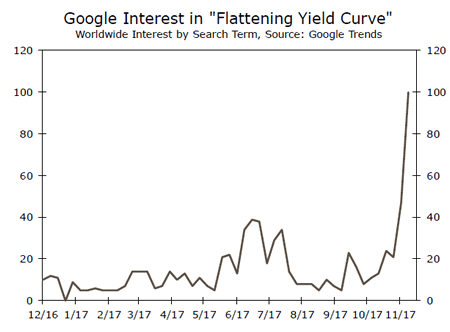
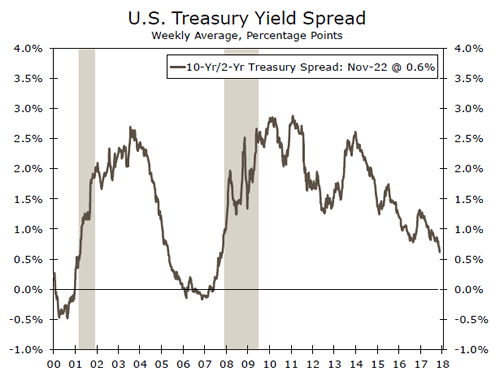
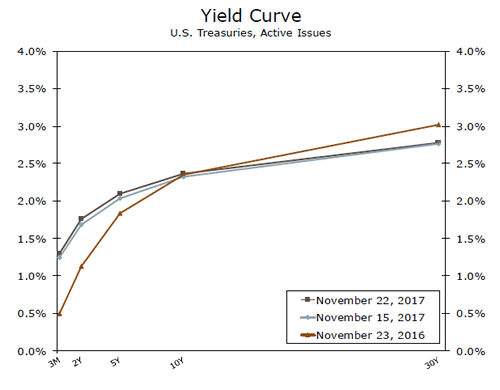
Credit Market Insights
Consumers Content on Credit Access
The New York Fed asks consumers about their experiences in the credit market every four months, and this week, released results for the October iteration. In keeping with the results of other subjective surveys this year, consumers were upbeat about access to credit.
The application rate was in-line with its series average for credit cards and auto loans but rose slightly for mortgages. The uptick in the mortgage application rate was driven by middle-aged (40 to 60 years) and mid-credit score (680 to 760) borrowers. The rate of rejection declined for each type.
Fewer consumers responded that they were too discouraged to apply even though credit was needed. Just 4.9 percent of the sample was too discouraged to apply which is a low point for the series that started in 2013.
Expectations for needing to apply for credit in the next year held steady for each credit type. Improvement on the expectations front came from fewer consumers saying that they expected their credit applications to be denied should the need arise.
The New York Fed asked a specific question about financial fragility, asking consumers if they could come up with $2,000 to cover an unexpected expense, and 70 percent of respondents answered yes.
The takeaway from this survey was that consumers are quite comfortable with their ability to obtain credit if needed. That is an important source of financial security.
Topic of the Week
2017 Holiday Sales Outlook
Consumer confidence is currently at its highest level since December 2000. Improved expectations coupled with a persistently positive attitude toward consumers’ present economic situation, point to an optimistic outlook for consumer demand this holiday season. We highlight that improved confidence figures have not translated to an expected uptick in personal consumption. Real personal consumption expenditures (PCE) have downshifted over the past few years, which has likely in part been an effect of a lack of income growth.
Our forecast for holiday sales this year is for an increase of 4.0 percent on a seasonally adjusted basis compared to only 3.0 percent for last year (top graph). According to the National Retail Federation media release, American consumers are planning to spend, on average, $967.13 during this holiday season, which is up 3.4 percent from what the survey indicated they were planning to spend last year (bottom graph). Fundamentals point to relatively strong consumer demand this season.
The projected uptick in sales is in-line with strong retail sales figures for October, which suggest solid momentum for spending headed into the fourth quarter. Likewise, the labor market remains supportive of relatively strong holiday spending, with the unemployment rate at just 4.1 percent and a continued rise in the demand for workers. We highlight that average hourly earnings have slowed slightly, although we expect firming in coming months due to the continued strength of the labor market.
Improved confidence in the future has outweighed the lack of income growth of the consumer. Confidence has brought down the saving rate at the same time as Americans have continued to borrow to complement income growth, helping keep PCE on a relatively stronger path than income growth would normally suggest. Strong confidence, coupled with high expectations of tax reform, could translate to an even larger bump in holiday sales than expected. We are projecting risks to our holiday sales forecast to be tilted to the upside this holiday season. For a more detailed analysis of our outlook, please read our full report here: 2017 Holiday Sales Outlook.
